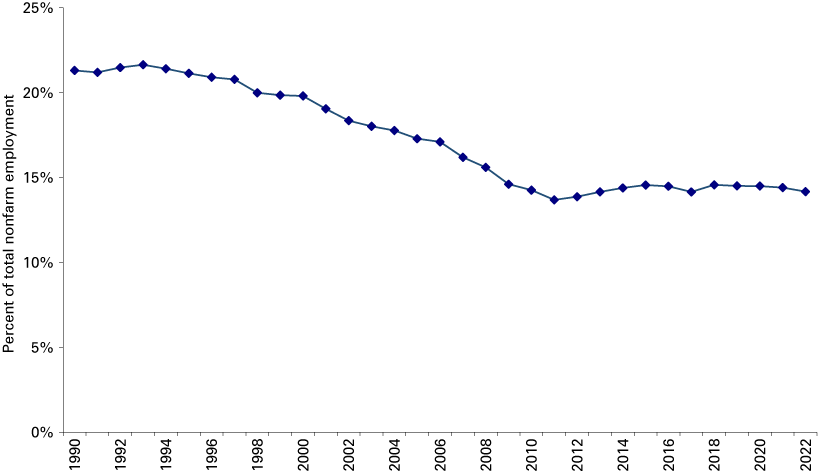Evansville forecast 2023

Professor of Economics and Provost, University of Southern Indiana
While indicators of global economic integration exhibit a downward trend1 since the financial crisis of 2007, global connectivity continues to have a significant impact on the direction and level of economic activity at the local, regional and national levels in the U.S. In 2022, developments such as the Russia-Ukraine conflict and ongoing supply chain issues led to larger-than-anticipated inflationary pressures and prompted several increases by the Federal Reserve of its short-term borrowing rate. With a cascading effect on other interest rates (such as mortgage rates) and inflationary expectations still at relatively high levels for much of 2022, there have been mixed effects on key indicators of economic activity in the Evansville region.
The 2022 forecasts for real output growth and personal income growth were 4.3% and 2.9%, respectively. While supply chain problems and inflation had an adverse impact on real output growth, nominal personal income growth is expected to exceed last year’s forecast. Regarding the employment level and the unemployment rate, however, it is anticipated that actual outcomes will not deviate considerably from the forecasts for 2022.
Once all data are released for 2022, real output and nominal personal income growth rates are estimated to increase by 0.9% and 3.6% respectively from their 2021 levels. The unemployment rate in the Evansville metro decreased from 2.5% in January 2022 to 2.3% in September 2022. The number of additional jobs estimated for 2022 is 4,670, which is close to the forecast of 4,700. The increase in jobs occurred primarily in the following sectors: manufacturing; professional and business services; and health services. The primary activities experiencing jobs losses were retail trade and government.
During 2022, there were several announcements of capital investment amounting to over $150 million in the Evansville region. This includes Avangard Innovative’s announcement of $100 million for the construction of a 500,000-square-foot manufacturing recycling facility in 2023 and DSM’s completion of a $60 million expansion and update of its manufacturing process.
In 2023, the number of jobs is projected to increase by 1,700, nominal personal income growth is forecasted to increase by 6.9%, real output is expected to increase by 2.5% and the unemployment rate is forecasted to be 2.7%.
The manufacturing sector continues to be an important base to metro-area household incomes and consumer spending activity, and exhibits relative stability as a share of total employment (see Figure 1).
Figure 1: Evansville metro manufacturing employment as a percent of total nonfarm employment

Note: Data is not seasonally adjusted. 2022 data are preliminary September data.
Source: STATS Indiana, using U.S. Bureau of Labor Statistics (Current Employment Statistics) and Indiana Department of Workforce Development data
As one of the most manufacturing-dependent metro areas in the nation, the Evansville economy continues to adjust to the impact of the Great Recession. While there is evidence of a COVID-19 impact, it appears to be much more transitory than the structural impacts of the Great Recession. Since 2007, Evansville’s manufacturing workforce has fallen by 11.8% or 3,000 workers, compared to a 2.5% reduction in Indiana’s manufacturing workforce over the same period. The manufacturing sector accounts for about 19% of total annual wages in the Evansville regional economy and as Table 1 shows, the manufacturing sector accounts for 14.2% of employment in the Evansville metro.
Table 1: Manufacturing’s percent of total nonfarm employment, September 2022
| Evansville metro | Indiana | U.S. | |
|---|---|---|---|
| Manufacturing | 14.2% | 16.7% | 8.4% |
| Durables | 37.8% | 70.2% | 62.1% |
| Nondurables | 62.2% | 29.8% | 37.9% |
Note: September 2022 data are preliminary.
Source: STATS Indiana, using U.S. Bureau of Labor Statistics and Indiana Department of Workforce Development data
Given the proportion of output that is sold outside the metro area, the economic vitality in the Evansville area is linked to the strength of the broader economy. As employment and demand for locally produced goods grow in the next year, employment, income and output are expected to increase.
A widening gap between the Evansville economy and the U.S. economy regarding trend growth in nondurable manufacturing over the past three decades highlights a key shift in the economic structure of the Evansville economy. Given the relatively high share of nondurable manufacturing employment, the Evansville region will face some additional challenges coping with inflationary pressures in 2023, since unit labor cost in nondurable manufacturing has increased at a much faster pace than unit labor cost in durable manufacturing over the last nine months.
Notes
- Douglas A. Irwin, “The pandemic adds momentum to the deglobalization trend,” Peterson Institute for International Economics, April 23, 2020, https://www.piie.com/blogs/realtime-economics/pandemic-adds-momentum-deglobalization-trend.



